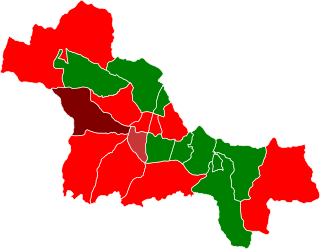
Local government is a generic term for the lowest tiers of governance or public administration within a particular sovereign state.

There are three types of elections in Nepal: elections to the Federal Parliament, elections to the provincial assemblies and elections to the local government. Within each of these categories there may be by-elections as well as general elections. Currently three electoral systems are used: parallel voting for House of Representatives and provincial assemblies, Single transferable vote for National Assembly and first past the post for local elections.

The National Assembly or Rastriya Sabha is the upper house of the Federal Parliament of Nepal, the lower house being the House of Representatives. The composition and powers of the Assembly are established by Part 8 and 9 of the Constitution of Nepal. There are a total of 59 members: 8 members are elected from each of the seven provinces by an electoral college of each province, and three are appointed by the President on recommendation of the government.

The administrative divisions of Nepal are subnational administrative units of Nepal. The first level of country subdivision of Nepal are the provinces. Each province is further subdivided into districts, each district into municipalities and rural municipalities, and each of those municipalities into wards. Before 2015, instead of provinces, Nepal was divided into developmental regions and administrative zones.
In South Africa, a local municipality or Category B municipality is a type of municipality that serves as the third, and most local, tier of local government. Each district municipality is divided into a number of local municipalities, and responsibility for municipal affairs is divided between the district and local municipalities. There are 205 local municipalities in South Africa.

Constitution of Nepal 2015 is the present governing Constitution of Nepal. Nepal is governed according to the Constitution which came into effect on 20 September 2015, replacing the Interim Constitution of 2007. The constitution of Nepal is divided into 35 parts, 308 Articles and 9 Schedules.
Local bodies in Tamil Nadu constitute the three tier administration set-up in the South Indian state of Tamil Nadu. It is a system of local government which forms the last level from the Centre. Chennai Corporation in the then Madras Presidency, established in 1688, is the oldest such local body not only in India but also in any commonwealth nations outside United Kingdom.

The Mayor of Hetauda is the head of the municipal executive of Hetauda. The role was created in 1969.

A municipality in Nepal is an administrative division in the Provinces of Nepal. The urban population of Nepal refers to the inhabitants residing in the designated municipal area. Population size has been taken as the principal criteria in the declaration of urban areas in Nepal since 1961. Municipalities can therefore also include rural areas. It functions as a sub-unit of a district. Nepal currently has 293 municipalities, which given the 2011 population estimate of 16,656,057.

A gaunpalika is an administrative division in Nepal. The Ministry of Federal Affairs and Local Development dissolved the existing village development committees and announced the establishment of this new local body. It is a sub-unit of a district. There are currently 481 rural municipalities.

District administration makes up the third level of government division in Nepal. The provision for a District Assembly, which acts as the legislature at the district-level, is mentioned in Part 17 of the Constitution of Nepal. The 77 districts of Nepal each have their own district assemblies which in turn elect their own District Coordination Committees, which serves as the executive at the district-level. In addition to this each district also has a District Administration Office which oversees the general administration of each district.

Municipal election for Kathmandu took place on 13 May 2022, with all 162 positions up for election across 32 wards. The electorate elected a mayor, a deputy mayor, 32 ward chairs and 128 ward members. An indirect election will also be held to elect five female members and an additional three female members from the Dalit and minority community to the municipal executive.

Municipal election for Lalitpur took place on 13 May 2022, with all 147 positions up for election across 29 wards. The electorate elected a mayor, a deputy mayor, 29 ward chairs and 116 ward members. An indirect election will also be held to elect five female members and an additional three female members from the Dalit and minority community to the municipal executive.
Municipal election for Pokhara took place on 13 May 2022, with all 167 positions up for election across 33 wards. The electorate elected a mayor, a deputy mayor, 33 ward chairs and 132 ward members. An indirect election will also be held to elect five female members and an additional three female members from the Dalit and minority community to the municipal executive.
Municipal election for Bharatpur took place on 13 May 2022, with all 147 positions up for election across 29 wards. The electorate elected a mayor, a deputy mayor, 29 ward chairs and 116 ward members. An indirect election will also be held to elect five female members and an additional three female members from the Dalit and minority community to the municipal executive.
Municipal election for Kalaiya took place on 13 May 2022, with all 137 positions up for election across 27 wards. The electorate elected a mayor, a deputy mayor, 27 ward chairs and 108 ward members. An indirect election will also be held to elect five female members and an additional three female members from the Dalit and minority community to the municipal executive.

The Municipal election for Rajbiraj were held in 13 May 2022 to elect a mayor, a deputy mayor, 16 ward chairperson and ward members. All positions are for a period of 5 years. A secondary election is to be held for the municipal executives which will elect 5 women from the elected ward members and 3 members who must be from the Dalit and minority community. The electorate for this election will be the 82 members chosen by direct election. Janata Samajwadi Party mayoral candidate Bhimraj Yadav was elected as a Mayor of Rajbiraj by securing 9,624 votes.

Municipal election for Hetauda took place on 13 May 2022, with all 97 positions up for election across 19 wards. The electorate elected a mayor, a deputy mayor, 19 ward chairs and 76 ward members. An indirect election will also be held to elect five female members and an additional three female members from the Dalit and minority community to the municipal executive.

The mayor of Kathmandu is the head of the municipal executive of Kathmandu Metropolitan City. The officeholder is elected for a five-year term and limited to serving no more than two terms. The role was first created in 1932 during the Rana regime.

The Mayor of Dharan is the head of the municipal executive of Dharan. The role was created in 1958.












